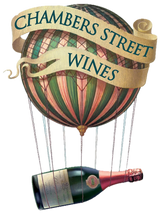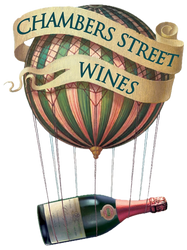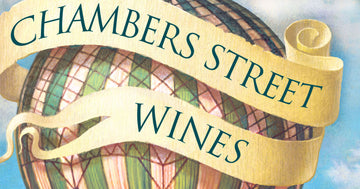Provence Legends - Clos Cibonne, Domaine Hauvette, Chateau Pradeaux, and Chateau Simone
4/3/2025

We will not be addressing the recent news on tariffs today. Surely our sifu, David Lillie will have some humorous and wise remarks to share in the near future. Instead, we will proceed with our previously planned itinerary, a voyage to Provence and an offer of some classic estates that are known for their terroir-driven, age-worthy wines, and not for pale, one-dimensional rosé! Included in today's offer will be wines from Clos Cibonne, Domaine Hauvette, Chateau Pradeaux, and Chateau Simone. Special thank yous to colleagues and friends who have penned some of the informative and eloquent texts below, namely John Beaver Truax (going waaaaaay back), Sophie Barrett and Pascaline Lepeltier.
‘Provence," just the word conjures the image of a perfect azur sky lost in the sapphire of the Mediterranean. Undulating lavender fields contrast with the gnarly olive trees and the slender, feather-like cypresses, the ever-changing light which inspired the Impressionists. The smell of heirloom tomato, thyme and cantaloupe, and the ocean of rosé wines. Provence was the first area in France to benefit from the vinicultural knowledge of the Greeks and the Phoenicians after landing in Marseille. The area immediately demonstrated superb potential for grape growing, and yet, within the past thirty years has become a caricature of itself, devoting more than 80% of its production to bland, technical, and soulless “al fresco dining” wine. In an effort to capitalize on the growing local tourism, the region has become flooded by mass-market ready-to-drink rosés crafted for an international audience more dazzled by the color of the wine than the quality.
A large majority of Provence producers have either forgotten or abandoned the true identity of their region. The terroir of Provence is world class, with exceptional variation, and is home to indigenous grapes able to produce artisanal haute-couture (and reasonably priced) expressions. Of course, some pioneers, visionaries, and vignerons have kept the original spirit of the region alive - the Rougiers of Château Simone in Palette, or the Tempier family or the Portalis of Château Pradeaux in Bandol. The example they have set has influenced a few first-generation winemakers to follow the same path. -Pascaline Lepeltier
Feel free to skip right to the wines by clicking below, or if you're thirsty for more reading, we've included bios and info on some of the estates from the Chambers Street Wines archives.
>>> View Wines Here <<<
Chateau Simone
Chateau Simone, barely known but well-respected among collectors, is in the minuscule appellation of Palette, only 43 hectares in its entirety. Chateau Simone is virtually the only producer in Palette and certainly the only Palette producer whose wines reach New York. This historic estate makes remarkably long lived wines: white, red, and rose. We are pleased to be able to offer some Chateau Simone Blanc and Rouge at prices below the cost of the current releases.
The Simone vineyards are located just south of Aix-en-Provence; the soil is limestone and the vineyard has northern exposure and is surrounded by pine forest. The vines, between 50 and 150 years old, are planted to Clairette, Grenache Blanc, Ugni Blanc, Bourboulenc, Picpoul, Furmint, Muscat, and some virtually unknown varieties - Terret Bourret, Aragnan, and Pascal. All harvesting and sorting is done by hand; only native yeasts are used for fermentation. The whites see 18 months in barrel and six months of aging on the fine lees. Though structured when young, the white is exceptionally long-lived.
The red is made of approximately 45% Grenache, 30% Mouvedre, 5% Cinsault and the remaining 20% is Syrah, Castet, Monosquin, Carignan, and several varieties of Muscat. Hand harvested, pressed with an old fashioned vertical press, fermented with native yeasts, matured in small barrels for eight months, then old casks for a year, the wine is then blended and bottled with no filtration. These are the most traditional of wines and you'll not regret picking up a few bottles to share with your friends over Mediterranean fare! - JBT

Clos Cibonne
This is a historic Domaine in the Côtes de Provence, famous for producing rosés aged an additional year under a veil of surface yeast called “fleurette.” Like an unconventional, French answer to the long-aged rosés of Lopez de Heredia, the rosés of Clos Cibonne offer a savory, spiciness on the nose and full, silken texture on the palate that is unique and transcendent of the category. The wines are based on the rare local grape variety, Tibouren, which Clos Cibonne has championed since the early 20th century when André Roux brought the estate to prominence and replanted Mourvèdre vines with Tibouren. Clos Cibonne is a 15 hectare estate about 800 meters from the Mediterranean. The soil is schist and the location of the vines, in a depression surrounded by hills, means an advantageous wind pattern cools them, offering relief from the scorching Provencal sun. The estate is now owned and run by André Roux’s granddaughter, Brigitte and her husband, Claude Deforge. Cibonne is farmed organically though the domaine is not certified.
For the most part, Clos Cibonne is planted to Tibouren, a vine that produces sweet and thin skinned grapes of uneven sizes that also ripen unevenly. In fact, some unripe grapes are left in the press to add spice and acidity to the resultant wine. On the morning of our visit (circa 2014), a crate of grapes awaited pressing and many small green berries could be seen amongst the deep purple. A further advantage of our timing was that we could taste unfermented Tibouren juice, nectar of the gods. Cibonne makes both an old vine and a young vine Tibouren Rosé; both are fermented in stainless steel before going into 100-year-old 1,000 liter foudres for their maturation.
These unusual and very delicious wines have developed a cult following. In case you’re interested in the results of forgetting a Rosé Vignettes in your cellar for a year or two, we drank a 1961 Rosé * alongside our Bouillabaisse and it was fantastic! - Sophie Barrett
*Sorry, we don't have any 1961 available, but we do have some vintage bottles straight from the temp-controlled cellar of their US importer!
Domaine Hauvette
Today, Dominique Hauvette produces some of the most beautiful wines of Provence (and France) in her biodynamic property at the foothills of the Alpilles. Dominique began her career in 1988 and her bottles are released when ready allowing some vintages to age. The elegance, complexity and length of her wines is remarkable. Why are they so remarkable? A combination of great terroir and a deep, naked sensibility to the vegetal and the mineral qualities of Nature.
Born in Paris, Dominique originally trained to be a lawyer. Her trajectory began to change after her father, a successful chemist, purchased a hotel in the area in the Val d’Isère. Her mother ran the hotel, and Dominique assisted by working in the hotel restaurant. When not bussing tables, she gave skiing lessons to ease the loneliness of the Alps. In 1980 she went on holiday in Provence, fell in love with the area and never left, working as a house painter to get by. In 1988 her father purchased a small property near Saint-Rémy-de-Provence with 2.5 ha of Grenache, Syrah and Cabernet, in a stunning, still wild area of Provence just south of Avignon. It is here that Dominique’s wine story begins. For a couple of years, she learned by herself, farming organically from the beginning, enjoying being quietly alone in her farm. She knew that she would need to make a high quality wine, a “vin de garde” with aging-potential, in order to charge the price necessary for the estate to survive. She began to form relationships with vignerons who would later become her mentors such as Noël Michelin of Domaine des Terres Blanches and Eloi Dürbach of Trevallon, the latter influencing her to use whole-cluster for added structure for her reds. She did it until a tasting at La Grange des Pères with Laurent Vallée in 1998 changed her perception. Since then she has destemed. Gaining confidence in her terroir and her wines, her attunement and synergy to her vines grew, and she slowly began to buy more plots. In 1999 she acquired 7 ha including a plot of old Cinsaults “droits” used for Améthyste. At this point she was still working alone and doing everything herself. In 2000, she converted the entirety of the property to biodynamic as a way to increase the energy of the plants and the soil. Combining reasoning and intuition, practicality and peasant wisdom, she has a deep, personal relationship to her biotope, including horses she raises on the property. Today, she cares for 13 ha of vines (of 17 potential).
Dominique farms 8 grapes - Cinsault (she shows all the potential of this grape!), Grenache, Carignan, Cabernet Sauvignon, Syrah for both red and rosé (more than 80% of the production), Clairette, Roussanne, and Marsanne for the red. The age and plot for each variety has changed over the years, as she pulled off some old vines whose yields were getting way too low, like her old vines Cinsault who gave in 2015 and 2016 barely 6 hl/ha. Same for some of her old grenache. She replanted using massale selections from her vines and neighbors' but to make sure about the quality of the plants she will start to do field grafting in the future, as the quality of the grafts she got back from the nursery were not always what she was hoping for. Woods, edges and fields are kept around the vines. Barely any tilling is done. She realized by working in the Roussillon that too much vigor leads to too much vegetation that leads to more diseases, so she is very careful about the vegetative growth, from the pruning to the leaf-pulling and debudding. She adopts different pruning techniques depending on the variety. She understands the importance of shade for the grapes not to burn. In the arid landscape where nothing really grows but vines and olive trees, she works on creating superior top soil. The main disease she faces is oïdium, mildiou once every ten years. She uses only copper and sulfur with the biodynamic preparations 500 and 501, and some tisanes (nettle) and essential oils. Unfortunately, it is getting harder and harder to find the plants as the French government (most likely lobbied by the pharmaceutical industry) introduces more and more regulation against the free foraging and the trades of these herbs!
In 2009 Dominique moved her cellar from her original tiny barn to a larger, more “modern” one built with the local limestone. There she has the space for 600 liter cement eggs (she was one of the first users in France) and 3,000 litre old foudres. These sizes matter very much for her, and suit the rhythm of harvest. She also hates the taste of oak. She uses some smaller inox tanks during vinification and blending. Harvest is done by hand, earlier and earlier, with a small team. Grapes are pressed in a pneumatic press - destemmed for the red, whole-cluster for the white and the rosé. The wines are settled overnight, and she keeps the “jus clair." The grosses lees are decanted multiple times and used for topping. No sulfur is used until malo is finished - it happens in every wine. Fermentations are of course spontaneous. Macerations are long (30+ days) and very gentle for the red. Dominique deeply believes Nature knows, and the less you intervene the better. Some rackings may happen in the winter if she notices some reduction. The length of aging depends on the cuvées, but most are aged for at least a year. She adjusts sulfur if needed before bottling, and bottles herself. Today we are offering a few cuvées available in the US, including the Dolia - her gorgeous white blend of Clairette, Roussanne and Marsanne (only available in Magnum currently). Thanks Dominique for these uncompromising, moving wines! - Pascaline Lepeltier


